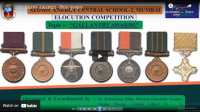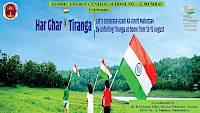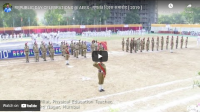Athletics
Some information about the sports event athletics
INTRODUCTION :
- Athletics is a group of sporting events that involves competitive running, jumping, throwing, and walking.
- World Athletics, is the international governing body for the sport of athletics
- World Athletics defines athletics in six disciplines: track and field, road running, race walking, cross country running, mountain running, and trail running.
- The Athletics Federation of India (AFI) is the apex body in Athletics in India.
- All forms of athletics are individual sports with the exception of relay races.
- Track Events :
- A variety of running events are held on the track which fall into three broad distance categories: Sprints, Middle-distance, and Long-distance track events.
- Sprints (100m, 200m, 400m), Middle distance (800m, 1500m), Long distance (3000m, steeplechase, 5000m, 10,000m).
- The Marathon is also a long-distance running event, usually run as a road race-taking place over a course of 42.195 kms.
- Hurdling is the act of running and jumping over an obstacle at speed.
- The most prominent hurdles events are 110 meters hurdles for men, 100 meters hurdles for women, and 400 meters hurdles (both men & women).
- Relay running is a type of running race in which athletes compete as a team, rather than as individuals.
- Relay races feature teams comprising four runners each, who must pass a baton to their teammate after a specified distance with the aim of being the first team to finish.
- The two most common relay races in track and field are the 4 x 100m and the 4 x 400m races, in which four athletes run 100m and 400m each respectively.
- Field Events :
The field events come in two types – Jumping and Throwing competitions.
- JUMPING EVENTS :
Jumping events include: a) Long Jump b) High Jump c) Triple Jump d) Pole Vault
- The long jump and triple jump are contests measuring the horizontal distance an athlete can jump.
- The high jump and pole vault are decided on the height achieved.
- THROWING EVENTS :
Throwing events include: a) Shot Put b) Discus Throw c) Javelin Throw d) Hammer Throw
In throwing events, athletes are measured by how far they hurl an implement, with the common events being the shot put, discus throw, javelin throw, and hammer throw.
- Combined Events :
- Combined events, which include the decathlon (10 events typically competed by men) and heptathlon (07 events typically competed by women), are competitions where athletes compete in a number of different track and field events, held over two days each . Points are awarded for each event and the overall winner is the athlete with the most points.
- The decathlon includes in the following order, for the first day: 100m, long jump, shot put, high jump, and 400m. The second day events are 110m hurdles, discus throw, pole vault, javelin, and 1500m.
- The heptathlon includes in the following order, for the first day: 100m hurdles, high jump, shot put and 200m. The second day events are long jump, javelin and 800m.
- TRACK EVENTS
- The 400m oval standard track forms the basis of a multi‑sports arena.
- The Track comprises two semicircles, which are joined by two parallel straights.
- The Track has eight, six or occasionally four lanes. All lanes have a width of 1.22m.
- There are three basic types of track surface—synthetic, unbound mineral (cinder) and grass.
- In races up to and including 400m (including the first leg of 4 × 100m, the Medley Relay and 4 × 400m), a crouch start and the use of starting blocks are compulsory. The official starter’s command shall be "On your marks", "Set" and "Clap/Whistle/Gun sound".
- In races longer than 400m, all starts shall be made from a standing position. The official starter’s command shall be "On your marks" and "Clap/Whistle/Gun sound".
- The Official Starter shall disqualify any athlete responsible for a false start in a race.
- The athletes shall be placed in the order in which any part of their bodies (i.e. torso, as distinguished from the head, neck, arms, legs, hands or feet) reaches the vertical plane of the nearer edge of the finish line.

-
FIELD EVENTS
- THROWING EVENTS
- SHOT PUT :
- The shot put is a throwing event involving "putting" a heavy metal ball (called the shot) as far as possible while remaining inside a 2.135 metre diameter circle.
- The shot is made of different kinds of materials which includes sand, iron, cast iron, solid steel, stainless steel, brass, and synthetic materials like polyvinyl.
- In open competitions, the men's shot weighs 7.260 kilograms and the women's shot weighs 4 kilograms.
- The shot must be released above the height of the shoulder with one hand
- The Shoulder must remain close to the chin or neck right through the action.
- The action of putting must start from a stationary position.
- The thrower must not touch the ground outside the circle, nor the top of the stop board or circle ring. The inside of the ring and stop board may be touched.
- The thrower must leave the circle from the rear half but only after the shot has landed.
- The shot is required to land within the legal sector.
- Each competition has a specific number of rounds and throws. The longest distance recorded wins.
- Once the athlete’s name/chest number is called, in case of more than 03 athletes, he/she have 30 seconds to release the shot.
Technique : a) Preparation b) Glide c) Delivery d) Recovery



- DISCUS THROW :
- The discus throw, also known as disc throw, in which an athlete throws a heavy disc called a discus in an attempt to mark a farther distance than their competitors.
- The discus should be made of solid or hollow wood or synthetic material with a metal rim encircling the discus.
- Dropping of the discus outside of the circle during initial swings before the turn and throw results in a foul attempt.
- If the discus lands on or outside of the sector lines, the throw is determined to be foul.
- The distance of each throw is measured from the nearest mark of the discus to the inside of the circumference of the circle.
- Athletes throw a metal disc weighing 2kg for men, 1kg for women, as far as possible while remaining inside a 2.5 metre diameter circle.
- During the course of throw, competitors may touch the inside of the circle's rim but cannot touch the top of the rim during the throw.
- The thrower cannot touch the ground outside the throwing circle during an attempt, nor can he or she leave the circle until the discus makes contact with the ground.
- Each competition has a specific number of rounds and throws. The longest distance recorded wins.
- Once the athlete’s name/chest number is called, in case of more than 03 athletes, he/she have 30 seconds to release the discus.
Technique : a) Preparation b) Swing c) Turn d) Delivery e) Recovery



- JAVELIN THROW :
- The Javelin throw is a track and field event where the javelin (a spear) is thrown as far as possible. The javelin thrower gains momentum by running within a predetermined area.
- The men’s javelin must weigh at least 800g and be 2.6m-2.7m long.
- The women’s javelin must weigh 600g and be 2.2m-2.3m long.
- The javelin must be held at the grip with one hand only and should always be maintained above the shoulder level.
- The athlete should not leave the ground until the javelin lands on the ground.
- A throw shall be valid only if the metal head strikes the ground before any other part of the javelin and within the marked 28.96 degree sector.
- If a thrower's foot touches or crosses the throw line, or outside the lines of the runway, it is a foul.
- Throwers cannot leave the runway until after the javelin lands.
- For the throw to be measured, the athlete must not turn his or her back to the landing area at any stage during their approach and throw.
- If the head of the javelin in contacting the ground first lands touches the sector line, the ground, or any object outside the sector line, it is a foul.
- Referees measure a throwers distance from the point of head of the javelin first struck the ground to the inside edge of the arc, along a line to the centre of the circle.
- Each competition has a specific number of rounds and throws. The longest distance recorded wins.
- Once the athlete’s name/chest number is called, in case of more than 03 athletes, he/she have 30 seconds to release the discus.
Technique : a) Approach b) 5 Step Rhythm c) Throw d) Recovery



- JUMPING EVENTS
- LONG JUMP :
- The long jump is a track and field event in which athletes combine speed, strength and agility in an attempt to leap as far as possible from a take-off point.
- The landing area shall have a minimum width of 2.75m and a maximum width of 3m.
- The landing area should be filled with soft damp sand, the top surface of which shall be level with the take-off board.
- The measurement of each jump shall be made from the nearest break in the landing area made by any part of the body, or anything that was attached to the body at the time it made a mark, to the take-off line, or take-off line extended.
- The measurement shall be taken perpendicular to the take-off line or its extension.
- An athlete fails if; he while taking off, touches the ground (including any part of the plasticine board/foul indicator) beyond the take-off line with any part of his body, whether running up without jumping or in the act of jumping.
- Somersaults are not permitted during the jump.
- Once the athlete’s name/chest number is called, in case of more than 03 athletes, he/she has to complete his jump within 30 seconds.
Technique : a) Run Up b) Take-Off c) Flight d) Landing








